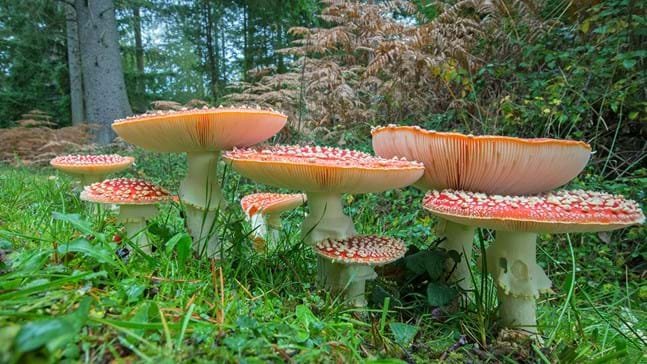Folklore around the Amanita muscaria mushroom
Introduction
Amanita muscaria, commonly known as the fly agaric, is iconic for its red cap and white spots
--you’ll likely recognize it from the Mario video games! Throughout history, the fly agaric has been frequently depicted in works of art,
Moritz von Schwind's 1851 painting of Rübezahl features fly agarics.[116]
and is referenced in ancient myths and folklore. It also has strong ties to religion due to its psychoactive properties, and documentation of its use by Siberian shamans dates as far back as the 17th century, though shamanistic use has likely been going on much longer than this.
Identification
Before we delve into the rich history of Amanita muscaria, we’ll cover its general characteristics and identification. Aside from the bright red caps with white spots (which measure 20 - 30 cm in diameter), the underside of fly agaric mushroom caps features gills that are either white or cream in color.
Credit: David Kjaer / naturepl.com
The stipe, or stem, is also white, and may feature scales or a skirt. Like morel mushrooms, if properly detoxified, fly agarics can be edible–detailed instructions for their preparation for safe consumption can be found here. However, if you are foraging for fly agarics, be careful not to mistake them for any of their related species, as they may be poisonous.
History
Phylogenetic analysis of Amanita muscaria reveals that the mushroom likely had its evolutionary origins in Beringia, the ancient landform that connected Asia and North America tens of millions of years ago. When the Bering Strait opened up between the two continents about twelve million years ago, the ancestral population of A. muscaria was fragmented. Radiation and expansion of the species continued, and now fly agaric mushrooms can be found on every continent except for Antarctica. The wide geographic distribution of the mushroom can be credited for its worldwide popularity.
Hallucinogenic Properties
Amanita muscaria contains ibotenic acid and muscimol, which are both neurotoxins. These toxins can cause unpleasant symptoms, like vomiting and drowsiness, but ingestion of them can also cause euphoria and auditory or visual distortions, which accounts for the fly agaric’s traditional use as a hallucinogenic.
Siberian Folklore
Prior to the expansion of Russia into Siberia, the eastern region of the land was isolated until explorers began traveling there. In the 20th century, Waldemar Jochelson, a Swedish-American ethnologist, lived with some of the tribes of eastern Siberia, and learned about their mythologies. One particular tale centers on a creature called the Big Raven, and the fly agaric mushroom. The myth tells the story of the origin of the fly agaric appearing at the beginning of existence. The Big Raven ate the mushroom, and then began to feel euphoric and started dancing. Consuming the mushroom also gave him a vision of a whale swimming in the ocean, so he lifted a bag containing a heavy whale and carried it out to sea. The Big Raven resolved to instruct his people to eat fly agaric mushrooms to have visions. The people of the Koryak tribe would thus ingest fly agaric mushrooms, and experience hallucinatory visions.
European Folklore
The fly agaric also has some interesting ties to the Christmas holiday. Siberian shamans have a tradition of dressing in red robes with white spots in honor of the mushrooms they harvest for religious rituals.
On the winter solstice, dried fly agaric mushrooms were given as gifts. Many scholars believe this wardrobe and ritual was a precursor to the red-and-white garb of Santa Claus, and the folkloric traditions of him giving gifts during midwinter. Siberian tribes also have close ties to reindeer, which would account for their popular imagery in Christmas art and decoration. One last interesting way that reindeer tie into the fly agaric is that reindeer frequently eat the mushroom, and the hallucinogenic toxins of the mushroom remain present in the animal’s urine. Collecting, boiling, and consuming the urine of reindeer that had eaten the mushroom was a safer way to ingest it for hallucinogenic purposes, because it is a method to dilute the poisonous elements of the mushroom.
Resources
Kevin Feeney (Ed.) (2020). Fly Agaric: A compendium of history, pharmacology, mythology and exploration. Ellensburg WA: Fly Agaric Press. Introductory material plus 486 pages with index and references
Nyberg, H. (1992). "Religious use of hallucinogenic fungi: A comparison between Siberian and Mesoamerican Cultures" (PDF). Karstenia. 32 (71–80): 71–80. doi:10.29203/ka.1992.294.
“Fly Agaric.” Woodland Trust. https://www.woodlandtrust.org.uk/trees-woods-and-wildlife/fungi-and-lichens/fly-agaric/
Rubel, W.; Arora, D. (2008). "A Study of Cultural Bias in Field Guide Determinations of Mushroom Edibility Using the Iconic Mushroom, Amanita Muscaria,as an Example" (PDF). Economic Botany. 62 (3): 223–43. doi:10.1007/s12231-008-9040-9
Rubel, William. “Amanita muscaria.” https://williamrubel.com/amanita-muscaria-is-edible-if-parboiled/
Geml J; Laursen GA; O'Neill K; Nusbaum HC; Taylor DL (January 2006). "Beringian origins and cryptic speciation events in the fly agaric (Amanita muscaria)" (PDF). Molecular Ecology. 15 (1): 225–39.
Lee, M. R., E. Dukan, and I. Milne. "Amanita muscaria (fly agaric): From a shamanistic hallucinogen to the search for acetylcholine." Journal of the Royal College of Physicians of Edinburgh 48.1 (2018): 85-91. https://www.rcpe.ac.uk/sites/default/files/jrcpe_48_1_lee.pdf
Xulu, Melanie. “Santa Claus, the Magic Mushroom & the Psychedelic Origins of Christmas.” Moof. https://moofmag.com/2017/12/12/santa-claus-the-magic-mushroom-the-psychedelic-origins-of-christmas/
Image Sources:
Image 1: https://en.wikipedia.org/wiki/Amanita_muscaria#/media/File:Amanita_muscaria_3_vliegenzwammen_op_rij.jpg - Attribution to Onderwijsgek
Image 2: https://en.wikipedia.org/wiki/Amanita_muscaria#/media/File:Ruebezahl_(Moritz_von_Schwind).jpg - Public domain
Image 3: https://wtlivewebtierstorage.blob.core.windows.net/cache/7/f/b/0/8/c/7fb08ca4d64cbb024fb0e585e3e884d5e06c6c58.jpg - Credit: David Kjaer / naturepl.com
Image 4: https://assets.website-files.com/621ccb89bd94da64b585efcd/6278f9b6f08617b3243fdd17_Emanuel-Salzman.jpeg - copyright Emanuel Salzman



